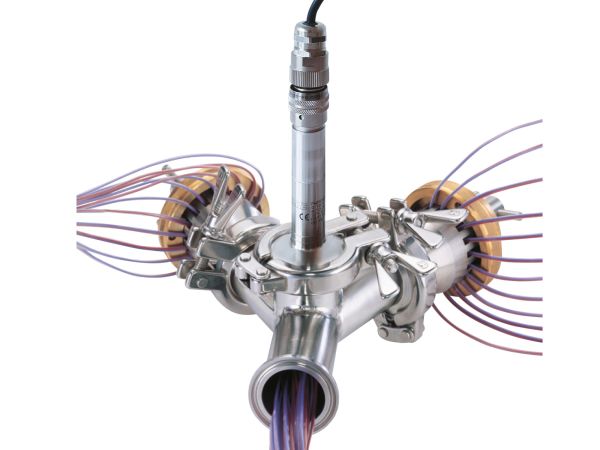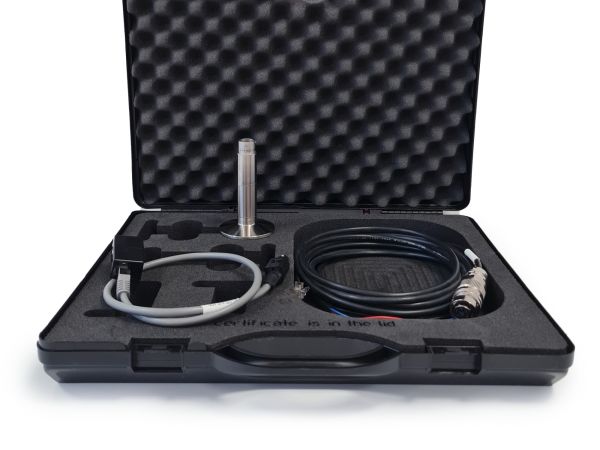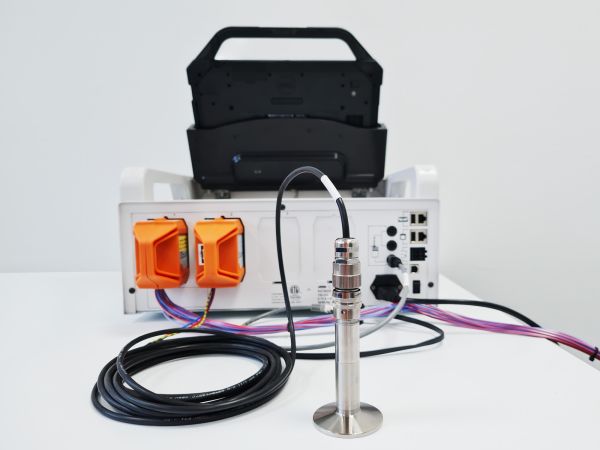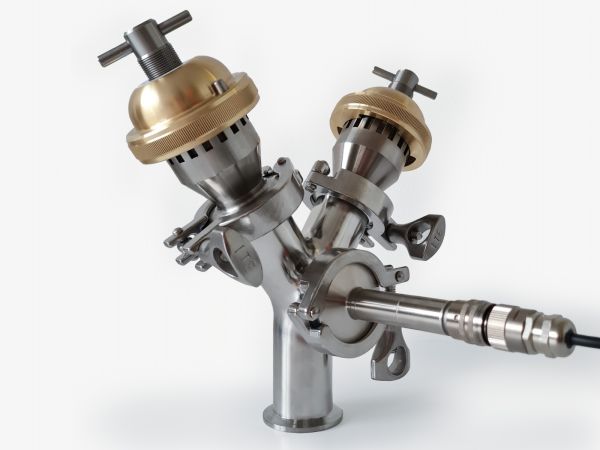



Kaye Pressure Transducer
High Precise Sensor for Autoclaves
Description
The Importance of Pressure and Temperature Measurements in Steam Sterilization
It is crucial to use a pressure transducer to measure pressure in parallel with the Temperature Measurement, when qualifying e.g., an autoclave.
Understanding the Ideal Gas Law in Sterilization
The success of a steam sterilization validation study hinges on careful monitoring of pressure, a key aspect that is deeply rooted in the principles of thermodynamics, specifically embodied through the Ideal Gas Law, expressed as PV=nRT. In this equation, each symbol holds a critical component: 'P' stands for pressure, 'V' denotes volume, 'n' refers to the number of moles of gas, 'R' is the universal gas constant, and 'T' represents temperature. Within the enclosed environment of a sterilizer, the boiling point of water, or the temperature at which its phase shifts from liquid to gas, rises concurrently with an increase in pressure. The steam that is produced under a given pressure at this precise boiling point is referred to as saturated steam. This type of steam exists in equilibrium with the heated water from which it was produced and carries the maximum possible amount of heat energy under the given conditions (temperature and pressure). This unique characteristic endows it with superior sterilization capabilities.
Role of Pressure in Steam Sterilization
The regulation of pressure within a steam sterilizer thus serves a dual purpose: controlling temperature and maintaining the conditions for saturated steam. An increase in pressure correlates with a higher sterilization temperature, and controlled pressure is essential in securing the ideal state for effective sterilization resulting in saturated steam. Pressure also facilitates guiding the steam into hard-to-reach areas of the items being sterilized. If the pressure is not high enough to support saturated steam, the sterilization process may be deemed incomplete. Further, maintaining pressure within defined limits throughout the sterilization process is a requirement stipulated by standard operating procedures and guidelines. This aids in validating the integrity of the vacuum systems where necessary and identifying potential leaks that may obstruct the sterilization process. A particularly important component of the sterilization process, specifically when ideal conditions for saturated steam are not obtained, is the scrutiny of steam quality. Signs of reduced saturation, as indicated by irregular temperature or pressure, could point towards a decrease in steam quality. The term 'steam quality' pertains to the ratio of actual steam to water droplets in a particular volume. High steam quality signifies a higher ratio of actual steam, directly influencing the efficiency of the sterilization process. Issues with steam quality could arise from various sources, including superheating, rapid pressure drops causing steam condensation, or possible mechanical problems in the boiler. In such cases, it is advisable to consult with a validation specialist or a sterilizer manufacturer. In conclusion, precise measurement, and control of pressure, coupled with an in-depth examination of steam quality, are crucial in achieving and maintaining effective and consistent sterilization conditions. These principles underscore our commitment to a meticulous sterilization method integrated deeply within the design and operation of our sterilization systems.
Kaye’s optimized Pressure Transducer works seamlessly with autoclaves and the Validator AVS and Validator 2000, eliminating the need for an external power supply. The pressure transducer ensures accurate and reliable Pressure Measurement, meeting the requirements of EN554, EN285 and ISO-17665.
In order to get accurate readings, both temperature and pressure are important factors to be thoroughly considered. This is where the Pressure Transducer comes in. The application of pressure transducers extends beyond just simple measurements. They are critical components, especially when dealing with dynamic pressure changes in different environments.
For instance, the careful monitoring of Pressure Measurement can help yield valuable data in scientific research, equipment troubleshooting, and process control applications. The importance of an accurate Pressure Measurement, therefore, cannot be overstated.
The Pressure Transducer has an inner mechanism functioning as a Pressure Sensor. This sensor detects pressure levels and converts this information into a readable output. The Pressure Sensor is basically a device that senses pressure and converts it into an electric signal where the amount depends upon the pressure applied.
In any equipment qualification involving Pressure Measurement, the use of a Pressure Transducer is highly recommended. It ensures that the data obtained is of the highest quality which is a critical part in maintaining and affirming product excellence.
The Pressure Measurement readings produced by the Pressure Sensor in the Pressure Transducer are invaluable in autoclave validation. In fact, they are crucial to ensure the proper functioning of many equipment and processes.
To adhere to the most stringent standards, it is essential to validate saturated conditions beside temperature. When high temperatures are reached within an autoclave, a correspondingly high-Pressure Measurement is necessary. The Pressure Measurement ensures that sterilization has occurred correctly, as it is this high pressure and temperature that eliminates micro-organisms.
The Need for Pressure Transducer Calibration at Operating Temperature
In the realm of pressure instrumentation, the calibration of devices such as pressure transducers under their operating temperatures is a critical aspect that dictates the level of accuracy and reliability of the measurements. This pivotal approach is necessitated by a commonly observed characteristic known as temperature compensation. Pressure transducers are put to use in various environments and conditions and are made up of components that may be sensitive to temperature changes. Any alteration in the temperature can lead to expansion or contraction of these components, which in turn has the potential to affect the functioning of the device and skew its readings significantly. When such a transducer is merely calibrated at room temperature and thereafter employed in an environment with higher temperatures (like 121°C, for instance), the output generated by the device can present considerable deviations from the exact pressure values. This situation can cause a significant error in pressure measurements, leading to inaccuracies in critical processes. To offset these potential anomalies, the transducer should ideally be calibrated under the same temperature conditions as its intended operation. This allows for the realization and subsequent correction of temperature-induced deviations, bestowing upon the pressure transducer the highest degree of measurement accuracy. Moreover, devices that include built-in temperature compensation mechanisms – engineered to counteract the effects of temperature variations – also necessitate calibration at operating temperatures. In summary, pressure transducers should ideally be calibrated at their operating temperature as opposed to room temperature to account for temperature compensation, ensuring the accuracy and reliability of the readings. This is particularly vital in applications requiring precise pressure measurements under specific environmental conditions. Observing this practice paves the way for dependable and precise readings that reflect the true pressure values in a given setting. They Kaye pressure transducers used in validation studies for a steam sterilizer will be calibrated at 121°C to achieve the best accuracy during use.
Benefitting from the Kaye Pressure Transducer in Autoclave Validation
Our Pressure Transducer, combined with the Kaye Validator System, provides Pressure Measurement readings that are precise. Of equal importance in this system are the Pressure Transducer itself and the Kaye Validator System, both of which work hand-in-hand to ensure accurate Pressure Measurement readings.
With its compatibility and adherence to industry standards, our Pressure Transducer is an essential tool for accurate autoclave performance assessment. It serves not just as a simple Pressure Sensor, but as an integral part of any process requiring exact pressure readings.
Choose the Kaye Pressure Transducer to achieve reliable and comprehensive autoclave validation. It meets industry standards, offers exceptional accuracy, and integrates seamlessly with the Kaye Validator System. This device not only ensures proper Pressure Measurement, but also has an integrated Pressure Sensor to maintain accurate readings at all times.
Concluding Note on the Importance of Accurate Pressure Measurement
In conclusion, the Kaye Pressure Transducer is a trustworthy and reliable tool in any environment, be it for simple assessment or complex scientific research. It doesn't merely measure pressure; it paves the way for further innovations and improvements in the field of Pressure Measurement. Far more than a tool – it is a standard-bearer, a testament to the continuous pursuit of excellence, demonstrating undeniably how crucial accurate Pressure Measurement is in various fields and industries.
Features
- Designed for the harsh environment applications such as steam sterilizers and SIP systems
- High performance pressure transducer, specified at full temperature range of autoclave
- Can be directly connected to 1.5 in triclover flange
- Full ISO-17025 traceable calibration over pressure and temperature range
- Ease of Use – wires directly to Kaye Validator with no additional wiring or power supplies required
Applications
- Autoclave
- Steam application
- SIP
Specifications
| Type | Absolute Pressure Transducer |
|---|---|
| Range | 0 bar to 4 bar (59 psia) Absolute |
| Sensitivity | 1V to 5V |
| Non-linearity & hysteresis | ±0.2% combined |
| Temp. compensated range | 110°C – 140°C |
| Accuracy | 10mbar (0.147 psi) at 110°C – 140°C |
| Calibration | Pressure calibration performed at 23°C and 121°C |
Software Support
The Kaye Validator Report Wizard provides EN554,HTM2010 and IS-17665 complaint reports. The user can create:
- Saturated Pressure and Temperature Graph Reports utilizing temperature and pressure actual data along side calculate saturated readings
- Automatic equilibration pass/fail determination
- Automatic Tb, Tb+3 limit determination based on temperature versus saturate temperature, or pressure versus saturated pressure.

